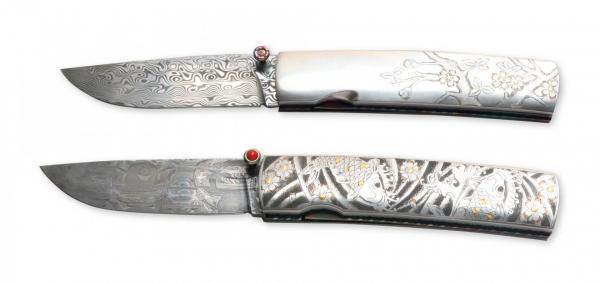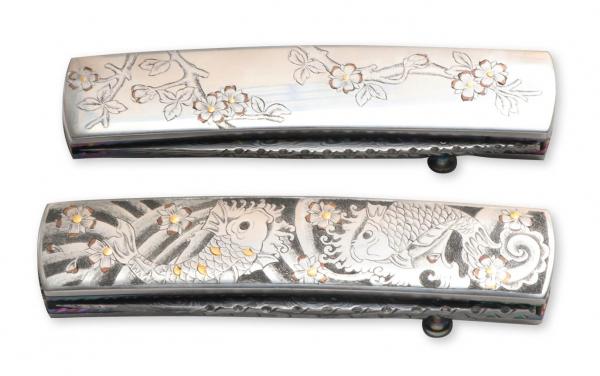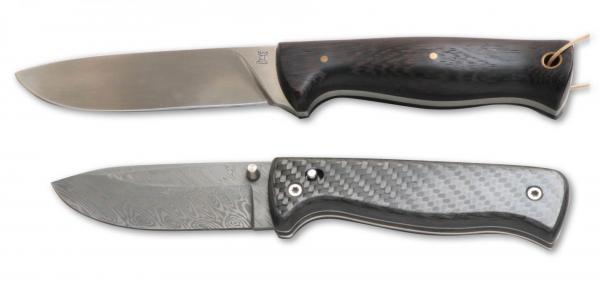Brno Autumn 2019
Brno Autumn 2019
The Autumn Knife Exhibition in Brno, Czech Republic, was held on November 16, 2019. There were some 80 knife makers and as usual, the quality of the work was very high.
Text and pictures: Martin Helebrant
Text and pictures: Martin Helebrant

Early visitors passing by the tables just after opening of the show.
For me, one of the undisputable signs of the autumn is the knife exhibition in Brno. Always a pleasant affair, organized by one of the most respected Czech - oh sorry - Moravian knife makers, Lubomír Maďarič. The venue is the traditional Via Crucis in the New Municipality House of Brno.
This year, the show featured more than 80 knife makers, indeed a very international band; more than 20 of them were foreigners. Apart from the anticipated strong Slovakian presence, there were Hungarians, Poles, and a Ukrainian master. Compared to the previous editions there were surprisingly few dealers in knife-making materials (steel, bone, horns, antlers, etc.); I noticed only two tables. The audience followed the Spring trend – there were around 900 visitors, but they were spread quite evenly throughout the day. There was neither a morning jam nor a lunch break silence. Maybe this was because of the weather, the cloudy and drizzling sky was hardly inviting for a walk outside.
For me, one of the undisputable signs of the autumn is the knife exhibition in Brno. Always a pleasant affair, organized by one of the most respected Czech - oh sorry - Moravian knife makers, Lubomír Maďarič. The venue is the traditional Via Crucis in the New Municipality House of Brno.
This year, the show featured more than 80 knife makers, indeed a very international band; more than 20 of them were foreigners. Apart from the anticipated strong Slovakian presence, there were Hungarians, Poles, and a Ukrainian master. Compared to the previous editions there were surprisingly few dealers in knife-making materials (steel, bone, horns, antlers, etc.); I noticed only two tables. The audience followed the Spring trend – there were around 900 visitors, but they were spread quite evenly throughout the day. There was neither a morning jam nor a lunch break silence. Maybe this was because of the weather, the cloudy and drizzling sky was hardly inviting for a walk outside.

Presenting the awards – on the left Mr Lubomír Maďarič, for many years the organizer of the exhibition,
on the right Mr Pavel Loutocký, Secretary to the Lord mayor of Brno – for many years a great supporter
of the exhibition.

There were 15 awards on the Autumn Knives Brno. These are most of the winners.
Jo nápot, kedves látogatók – Have a nice day, dear visitors. Most notable on the actual Brno exhibition was the strong Hungarian presence. Hungarians have always come, but this time they represented a good 10% of the exhibitors. Hungarian késkészítek – knife makers - have a distinct ‘watermark’ in their work. They combine a high level of craftsmanship with an excellent design, which sometimes may be rather minimalistic. A good example of the traditional Hungarian knives was the work of the young master Ferencz Kocsis, who exhibited traditional bicska - folders. They are simple by design and materials, yet they had a great appeal. The same minimalistic approach was visible on knives of Attila Kertész: simple, but carefully tuned lines and excellently made. From a total of 15 awards (Brno is always rich in awards) the Hungarians gained three, significantly more than their percentage of the exhibitors.
Jo nápot, kedves látogatók – Have a nice day, dear visitors. Most notable on the actual Brno exhibition was the strong Hungarian presence. Hungarians have always come, but this time they represented a good 10% of the exhibitors. Hungarian késkészítek – knife makers - have a distinct ‘watermark’ in their work. They combine a high level of craftsmanship with an excellent design, which sometimes may be rather minimalistic. A good example of the traditional Hungarian knives was the work of the young master Ferencz Kocsis, who exhibited traditional bicska - folders. They are simple by design and materials, yet they had a great appeal. The same minimalistic approach was visible on knives of Attila Kertész: simple, but carefully tuned lines and excellently made. From a total of 15 awards (Brno is always rich in awards) the Hungarians gained three, significantly more than their percentage of the exhibitors.

A ‘Cakli Bicska’ (traditional folder) by Hungarian maker Ferencz Kocsis. The 92 mm slip-joint blade is
Carbon Damask, the handle is Horn and Alpaca.

Two knives by Hungarian maker Attila Kertész, resembling flint. The blade material is in fact Bö 690 (top)
and ATS 34. The handle material of the upper knife is Ebony and the knife measures 224 mm. The lower
knife is 170 mm long and has a Shed oak handle.

Slovakian knife maker Arpád Bojtoš (SK) presented this ‘Africká noc’ (African night), which received the
award of the Lord mayor of Brno. The 230 mm knife is made from one piece of ATS 34, with a heavily
sculpted handle.



This ‘Art Deco’ by Slovakian knife maker Štefan Albert, won the Best of Exhibition Award. The 193 mm
blade is Damask by G. Verezhnikov, the handle material is Buffalo horn. The overall length of the knife is
332 mm.
One of the features of the Brno show was the presence of many highly decorative knives - some resembled more sculptures or works of art than a tool. Notable were the high-quality works of Arpád Bojtoš, closely followed by Albert Štefan and Richard Chromý (all from Slovakia), but also by Jaroslav Čech. But not everything needs to be so ornately. Look, for instance, at the sober beauty of the folding knives by Dušan Báča, with their Orientally-inspired engraving. Decent, simple and still perfect.
One of the features of the Brno show was the presence of many highly decorative knives - some resembled more sculptures or works of art than a tool. Notable were the high-quality works of Arpád Bojtoš, closely followed by Albert Štefan and Richard Chromý (all from Slovakia), but also by Jaroslav Čech. But not everything needs to be so ornately. Look, for instance, at the sober beauty of the folding knives by Dušan Báča, with their Orientally-inspired engraving. Decent, simple and still perfect.

‘Vinum Celebrationem’ (Wine Celebrations) by Richard Chromý (SK). The 232 mm long blade is Carbon
Damask, the handle is Mammoth tooth and Bö N690. The overall length is 389 mm.




Czech maker Jaroslav Čech presented the ‘Austrálie’ (Australia). The knife is made from one piece of Balbach
Damask, and has a 140 mm blade.

Two knives by Slovakian maker Dušan Bača. The top knife is the Sakura, the lower knife is aptly named
‘Koi kapri’ (Koi Carps). Both have an 80 mm RWL 34 blade and Titanium and Mokume handles.

As far as working knives are concerned, I would like to mention the knives of Max Netrval with strongly accented damask blades, a replica of a medieval hunting dagger with an accompanying small knife and a pick made by Miroslav Pouzar, and last but not least the knives made by Václav Šmíd. On the heavy side, there were large machetes or heavy choppers made by the young blacksmith (and freshman on the exhibition) František Kundera. They are intentionally made in a slightly crude form but with a perfect function. [One of his knives was shown in European Blades Mag. 27, in our Ybbsitz show report, ed.]

Two fixed blades by Max Netrval (CZ), both with a Caron Damask blade. The upper knife has a blade length
of 195 mm and an Ebony and Ostrich bone handle. The lower knife has a 125 mm blade and a Brass and
Ostrich bone handle.

A replica of a Medieval hunting set by Miroslav Pouzar (CZ), consisting of a hunting dagger, a small knife
and a pick, all made from 14 101 spring steel. The dagger has a 285 mm blade and an Ebony and Brass handle.

A fixed blade by Václav “Monty” Šmíd (CZ). The 100 mm blade is a Nickel steel and Carbon sandwich.
The grip is Horn and Walnut. The overall length of the knife is 200 mm.

The table of a freshman on the exhibition, František Kundera and his heavy blades.
When speaking about freshmen on the exhibition, one cannot omit the straightforward farmer’s folders by Radek Hrdlička, which present a good example of a mature design coupled with nice craftsmanship. It is a pleasure to see freshmen of such quality.
When speaking about freshmen on the exhibition, one cannot omit the straightforward farmer’s folders by Radek Hrdlička, which present a good example of a mature design coupled with nice craftsmanship. It is a pleasure to see freshmen of such quality.

Three farmer knives by Czech maker Radek Hrdlička. The blade materials are (from top to bottom) Carbon
Damask, N690 and Carbon Damask, The handles are Olive wood, maple and Kirinite.
Regular readers will remember a nice Viking sword from the Příbram exhibition report; now Brno has presented its own. This has been made by Aleš Karban, a blacksmith known for his interest and capability of processing wootz steel. His sword is a rider’s one, the overall length exceeds one meter. The brass pommel is decorated by a simple silver inlay and the brass hilt is doubled with a spacer made from black buffalo horn. The sword is accompanied by a large knife in the same period style, albeit with different grip materials. Like the Ulík sword in Příbram, this Karban sword is perfectly balanced and fully functional – a wonderful warrior’s companion of a high degree, ready to sing it’s glorious but deadly song. It has been righteously awarded.

Czech maker Aleš Karban presented a Cavalry Viking sword and dagger. The blades of both are made from
Damask from five different types of steel. The sword handle is Brass, Horn and Bog oak. The dagger has a
handle from Horn and Guaiacum. The overall length of the sword is 1030 mm, the dagger measures 347 mm.

Finally, I would like to say few words about the work of Lubomír Maďarič, the organizer of the exhibition and a knife maker of high degree. He is known for his famous fighting knives, appreciated also by military and police special forces and teams in the Czech Republic but this is not the only type of cutlery he makes. His heart and hands also belong to excellent replicas of historical blades, usually from the baroque period or made in the baroque style, such as the hunting dagger with Damask blade and Walrus tooth handle that he presented this time.
But it was not alone. There were two beautiful sabers – one in the Hungarian (please keep in mind that Mr Maďarič has deep family roots from Hungary) aristocratic style with turquoise gems on the grip and sheath, the second with a lion head grip and silver sheath furniture. The blades are made from carbon damask decorated by golden inlays. Both sabers are perfectly balanced and functional and both are inspired by historical originals. Some 200 years ago, noblemen would pay a fortune for them (Mr Maďarič values the sabers at well over 10,000 Euro each) and the master would deserve every penny of it.
The production of the sabers was a cooperation of various master craftsmen. It is another of Mr. Maďarič’s skills: he is capable to find, inspire and coordinate efforts of his collaborating partners – masters of their trade – in creating something so complexly beautiful and yet absolutely functional.
As a closing word – there were 15 awards on the Autumn knives Brno 2019. I will name only some (and please keep in mind that the awards are granted to the knife maker for his skills in a particular field, not for one specific blade). Mr Maďarič was awarded twice, for the historic replicas and for the fighting knives; overall best of the exhibition award was granted to Mr. Štefan Albert; the award of the Lord mayor of Brno went to Mr. Arpád Bojtoš and the award for the best engraver went to Mr. Jaroslav Čech. The awards were presented to the awarded masters by Mr Maďarič as an organizer and Mr Pavel Loutocký, secretary to the Lord mayor of Brno.
I am cordially inviting you to the spring Brno exhibition 2020 which will be held on March 28th.
But it was not alone. There were two beautiful sabers – one in the Hungarian (please keep in mind that Mr Maďarič has deep family roots from Hungary) aristocratic style with turquoise gems on the grip and sheath, the second with a lion head grip and silver sheath furniture. The blades are made from carbon damask decorated by golden inlays. Both sabers are perfectly balanced and functional and both are inspired by historical originals. Some 200 years ago, noblemen would pay a fortune for them (Mr Maďarič values the sabers at well over 10,000 Euro each) and the master would deserve every penny of it.
The production of the sabers was a cooperation of various master craftsmen. It is another of Mr. Maďarič’s skills: he is capable to find, inspire and coordinate efforts of his collaborating partners – masters of their trade – in creating something so complexly beautiful and yet absolutely functional.
As a closing word – there were 15 awards on the Autumn knives Brno 2019. I will name only some (and please keep in mind that the awards are granted to the knife maker for his skills in a particular field, not for one specific blade). Mr Maďarič was awarded twice, for the historic replicas and for the fighting knives; overall best of the exhibition award was granted to Mr. Štefan Albert; the award of the Lord mayor of Brno went to Mr. Arpád Bojtoš and the award for the best engraver went to Mr. Jaroslav Čech. The awards were presented to the awarded masters by Mr Maďarič as an organizer and Mr Pavel Loutocký, secretary to the Lord mayor of Brno.
I am cordially inviting you to the spring Brno exhibition 2020 which will be held on March 28th.

A Baroque-style hunting sword (Hirschfanger) by Czech master Lubomír Maďarič, organizer of the Brno
exhibition. The blade is Carbon Damask, etched and gold-inlaid. The handle is carved Walrus tooth, just
like the fittings of the scabbard. The overall length is 608 mm.

Lubomír Maďarič also presented two beautiful sabers – one in the Hungarian aristocratic style with
turquoise gems on the grip and sheath, the second with a lion head grip and silver sheath furniture. The
blades are made from Carbon Damask decorated with golden inlays.


Two fixed blades by Bohumil Šrom. The blades are Carbon 19 312 and stainless Damask. The upper knife
has a Bog oak handle and measures 303 mm. The lower knife has a Grenadille handle and measures 242 mm.

A traditional Hungarian knife set by Hungarian maker Ferencz Kocsis. The set consists of a knife and fork,
which can be coupled. When the fork is folded, it locks the two pieces together. The steel is 14 116, the
handles are made from Horn and Brass. The knife has a blade length of 94 mm.


Two liner lock folding knives by Czech maker Jan Samek (R&H Knives). The upper knife has a 105 mm
Elmax blade, the lower has an 108 mm Balbach Damask blade. Both have Carbon Fiber handle scales.

Hungarian knife maker Jószef Jeneses won the award for Utility Fixed Blade with these kitchen knives.
The upper knife has a 174 mm Wolf Stainless Damask blade and Warthog and Macassar handle. The
lower knife has a 202 mm WG104 blade and handle made of Cactus.

An engraved Skinner by Karel Borecký (CZ). The 100 mm blade is made from RWL 34, the handle material
is Olive wood and Brass.

A fixed blade by László Tóth (HU). The 85 mm blade is made from Bö N690, the handle material is
stabilized Maple. The overall length of the knife is 227 mm.

A fixed blade and a folding knife by Slovakian maker Štefan Galovič. The upper knife has a 110 mm Elmax
blade and a Wenge handle. The folder has a 90 mm Damasteel blade and Carbon Fiber handle scales.


Tomáš Bittner (CZ) presented these two fixed blades, both made from a 19 312 Carbon steel and 19 418
Tool steel sandwich. The upper knife has 172 mm blade and a Chestnut handle. The lower knife has a
129 mm blade and an Alder and Reindeer handle.

A Kukri by Zlatroustskie nozhi from Russia. The 300 mm blade is Zladinox Damask, the handle is Macassar
wood and Mokume. The knife has a bit unusual combination of the Nepalese traditional shape and Japanese characters.